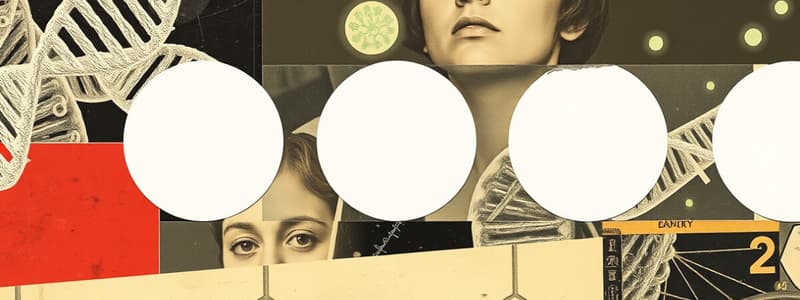Podcast
Questions and Answers
What is the primary role of structural genes in gene expression?
What is the primary role of structural genes in gene expression?
- Encoding functional proteins (correct)
- Controlling cellular metabolism
- Regulating the expression of other genes
- Producing ribonucleic acid only
How does the presence of an inducer affect the lac operon?
How does the presence of an inducer affect the lac operon?
- It activates the structural genes directly.
- It inhibits the activity of RNA polymerase.
- It degrades the messenger RNA immediately.
- It causes the repressor to change shape and release from the operator. (correct)
Which of the following correctly describes an operon?
Which of the following correctly describes an operon?
- A protein that interacts with RNA polymerase.
- A sequence of DNA that contains structural genes and is transcribed as a single unit. (correct)
- A type of regulatory gene that functions independently.
- A mechanism that permanently alters gene expression.
What percentage of human DNA consists of regulatory genes?
What percentage of human DNA consists of regulatory genes?
Which of the following proteins is NOT coded by the lactose operon?
Which of the following proteins is NOT coded by the lactose operon?
What happens to the trp repressor when tryptophan levels are high?
What happens to the trp repressor when tryptophan levels are high?
How does attenuation reduce the expression of the trp operon?
How does attenuation reduce the expression of the trp operon?
What role does the ribosome play in the process of attenuation?
What role does the ribosome play in the process of attenuation?
What is the primary consequence of a ribosome rapidly finishing the translation of the leader polypeptide?
What is the primary consequence of a ribosome rapidly finishing the translation of the leader polypeptide?
What structural feature of the attenuator region contributes to its ability to form hairpin structures?
What structural feature of the attenuator region contributes to its ability to form hairpin structures?
Flashcards are hidden until you start studying
Study Notes
Gene Expression
- Multistep process leading to functional gene products: RNA or protein.
- Cells regulate production of RNA and protein from DNA.
Central Dogma of Molecular Biology
- Two main gene groups:
- Structural Genes: Protein coding genes comprising ~20,400 in humans, making up ~2% of human DNA.
- Regulatory Genes: Genes that regulate structural protein production, accounting for ~98% of human DNA.
Regulation of Prokaryotic Gene Expression
- Operons are clusters of genes transcribed together as a single mRNA molecule.
- Lactose Operon: Contains an operator that binds a repressor protein, blocking mRNA production unless an inducer is present.
- lacZ gene: Codes for β-galactosidase, hydrolyzing lactose to glucose and galactose.
- lacY gene: Codes for permease, facilitating lactose entry into cells.
- lacA gene: Codes for thiogalactosidetransacetylase, acetylating lactose.
- Trp Operon regulation involves:
- Trp Repressor: Active when tryptophan is present, blocking transcription.
- Attenuation: Reduces expression when tryptophan levels are high by preventing full transcription completion.
- Ribosome behavior during translation influences hairpin structure formation in mRNA, affecting termination of transcription.
Attenuation Mechanism
- Leader region: Contains attenuator, which can form hairpins influencing transcription.
- Low tryptophan: Ribosome stalls, preventing formation of terminator hairpin; transcription continues.
- High tryptophan: Ribosome quickly translates leader, forming terminator hairpin that leads to transcription termination.
Regulation of Eukaryotic Gene Expression
- Eukaryotic gene expression is complex, regulated mainly during transcription.
- Gene components:
- Exons: Expressed DNA sequences coding for proteins.
- Introns: Non-expressed sequences between exons.
- Start site: RNA Polymerase II binding location.
- Promoters: Core promoters (e.g., TATA box) present in all eukaryotic genes; upstream promoters vary per gene.
- Enhancers/Silencers: DNA sequences that modulate transcription rates from a distance.
Transcription Factors
- Proteins that regulate transcription by binding to DNA sequences.
- Structure:
- DNA Binding Domain (DBD): Binds specific DNA sequences.
- Transactivation Domain (TAD): Binds co-regulatory proteins.
- Signal-Sensing Domain (SSD): Occasionally present, allows interaction with signaling molecules.
Clinical Correlates
-
Huntington’s Disease (HD):
- Autosomal dominant neurodegenerative disorder caused by CAG repeat expansions in the HTT gene.
- Leads to mutant huntingtin protein accumulation in neurons, causing cell death and symptoms including motor dysfunction and cognitive decline.
- Ongoing research focuses on gene silencing therapies.
-
Duchenne Muscular Dystrophy (DMD):
- X-linked recessive disorder marked by progressive muscle degeneration due to mutations in the DMD gene encoding dystrophin.
- Characterized by muscle fiber integrity loss, delayed motor milestones, and potential cardiopulmonary complications.
- Therapies like exon skipping aim to restore functional dystrophin production.
Muscle Stabilization in DMD
- Copolymer-based strategies enhance muscle membrane stability by preventing extracellular calcium influx, promoting muscle health despite dystrophin absence.
Studying That Suits You
Use AI to generate personalized quizzes and flashcards to suit your learning preferences.


